We have done extensive research & hands-on review of Bambu Lab X1 Carbon and will suggest a comprehensive comparison between Bambu Labs X1 Carbon, Prusa XL, and Makerbot Method X & Troodon
It aims to make your decision-making easier and tries to evaluate the best alternative to Bambu labs x1 carbon 3d printer.
We will elaborate on all four 3d printers – specifications comparison along with the print quality assessment.
Bambu Lab X1 Carbon – Key Takeaways
These are the critical factors that make Bambu Lab X1 Carbon different from others
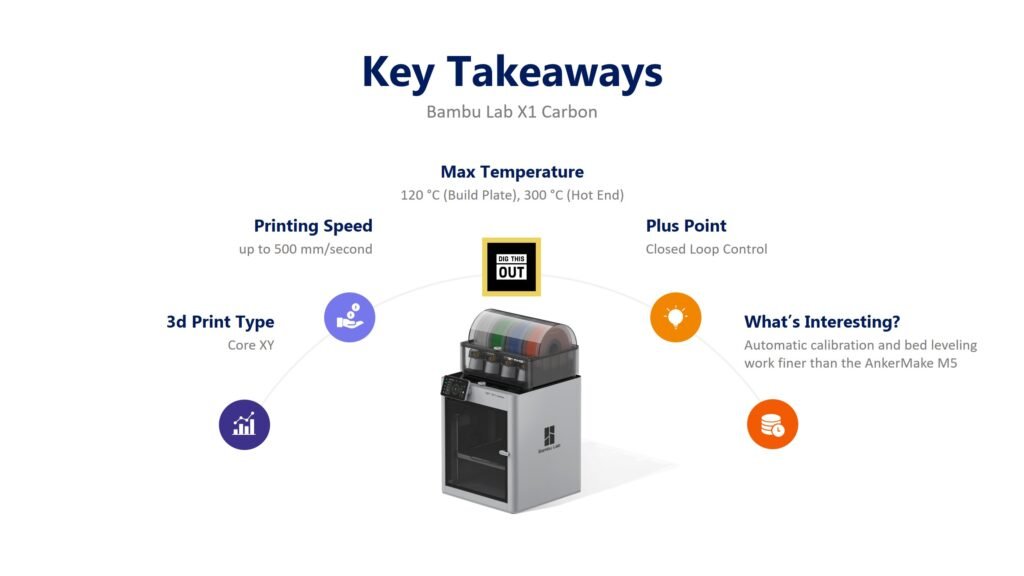
Check if it's available in Amazon
- Core XY 3d printer with multiple filaments switching flexibility
- Premium Appearance
- Automatic nozzle switching flexibility as per the G code
- Larger build plate
- Stainless steel made
- Transparent filament feeding hopper that holds 4 filament rolls
- No purge tower required
- All metal hot end with maximum nozzle temperature of 300 degrees Celcius
- No warping noticed
- 500 mm per second of print speed makes it amazing
- 32 mm^3/s max hot end flow helps in faster printing
- Cools quickly
- Comes with a premium enclosure
- The activated carbon filter helps protect us from toxic fumes
- Works with tough materials such as ABS & PETG
- Automatic calibration and bed leveling work finer than the AnkerMake M5
- 1080 pixel AI camera attached with the nozzle
- Cleaning and maintenance are a bit complex due to non-removable enclosures
- Controllable in smartphone
- The AMS saves you from incurring additional costs for dry box & humidity controller
- RFID tags detect Bambu labs filament automatically and adjust the slicer profiles accordingly (a value addition)
- Unfortunately larger filament rolls do not fit into the filament hopper. The same problem we have also noticed in AnkerMake M5. It could be a tick to purchase the Bambu Lab’s filaments (a good marketing trick)
- Hotend reaches 200 C in roughly 30 seconds which saves pre-heating lead time like other 3d printers. In 1 minute 20 seconds, the hot end reached to a maximum temperature which is awesome.
- Heating takes a minute extra (2 minutes in total) to reach the maximum temperature of 120 C.
- The bed heats evenly which is a very good sign but there is no such flexibility of partial heating as Prusa XL.
Installation & Printing (X1 carbon)
We received Bambu Lab’s X1 Carbon on time which took around 15 minutes to install. Here’s how it looked like

The product packaging was great, delivery was on time, and setup was super fast. After auto-calibrating and filament placement, we quickly went into the printing process.
Let’s have a look at how it looked like and performed overall:
It was cool, isn’t that!
These were the printings we received from the X1 Carbon after a day.

Print Speed Test of Bambu Lab X1 Carbon
For the X1 Carbon – Balbu lab has mentioned a print speed of 500 mm per second and we ran a few 3d print models to check whether it’s true.
These are the hands of tests done by the Bambu Lab X1 Carbon which shows that the speed is really amazing compared to other 3d printers within the similar budget.
The Wave Lamp Print
This wave lamp is a 3d model from printables. It is printed in PAHT and PAHT CF in 0.24mm layers and 5% infill settings. It took 7 hours and 23 minutes to get the 3d prints done with Bambu Lab X1 Carbon.
The speed was amazing and the quality was awesome.
There was no error noticed in the first layer and as well as within the middle.
Here’s what we got from the Bambu X1:
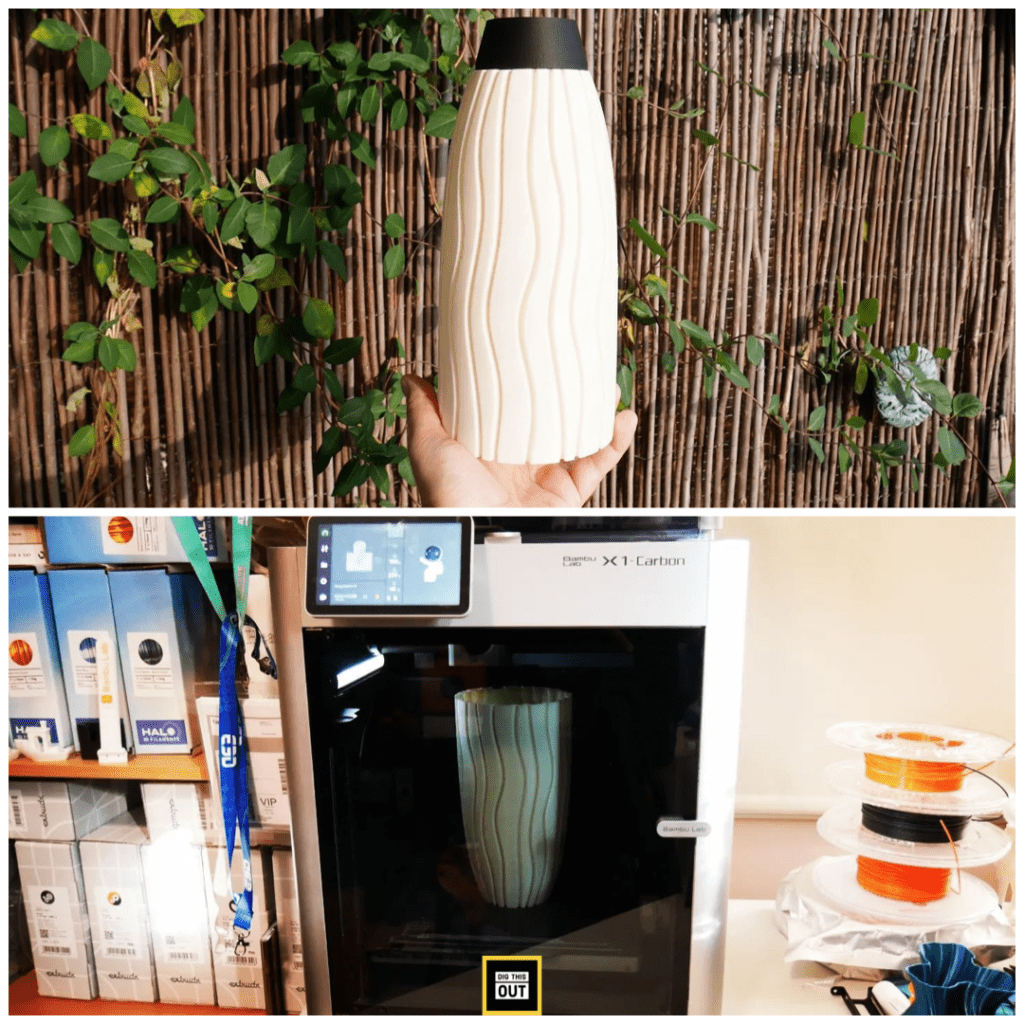
The Blossom Vase print by Bambu Lab X1 Carbon
Then we tried a blossom vase with Bambu X1 Carbon. The 3d model was from Printables as well.
We used the Aqua Blue filament as an experiment and the print took only 1 hour and 31 minutes in total. We have used 2 walls and 5 bottom layers with a layer height settings of 0.16mm.
Here’s what we got!

Organic Sculptures by Bambu Lab X1 Carbon
Here’s another experimental print with Bambu Lab X1 Carbon. The 3d model was an organic sculpture.
We choose to go with a layer height of 0.2 mm and an infill percentage of 10%. We used silver PLA as our primary filament and the print took 9 hours to get done with an amazing end result.
Here’s the 3d print of organic sculptures done with Bambu Lab X1 Carbon:

Funnel Print Experiment by Bambu X1
Then we went for printing a funnel on Bambu X1. The total height of the 3d print was 137 mm. Here’s the result that we have got:
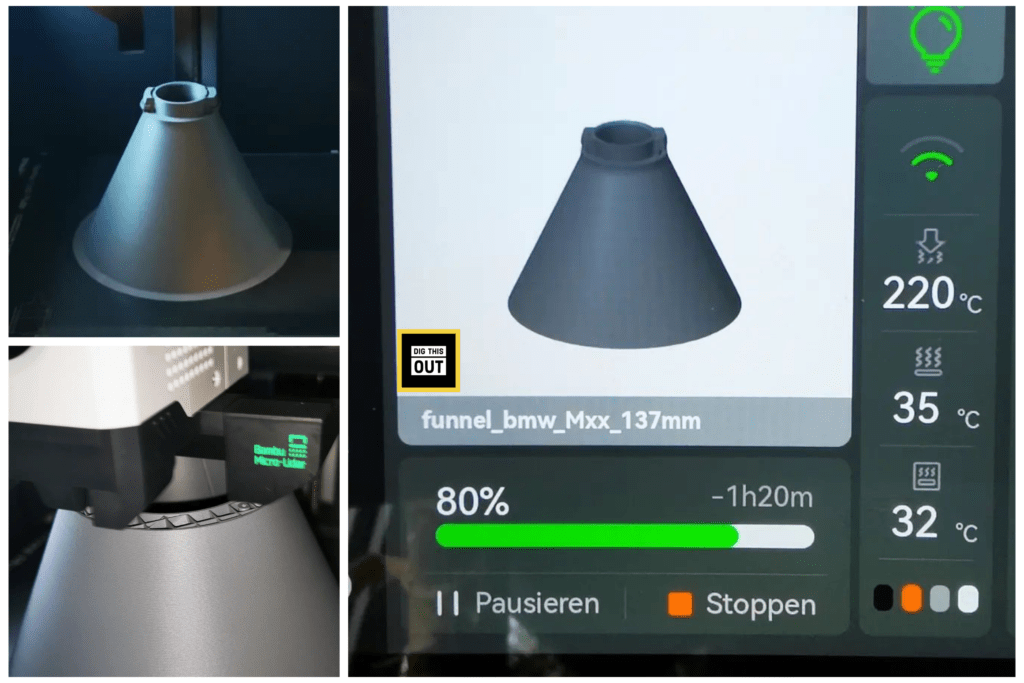
Noise Level Test
Bambu Lab has officially proclaimed their 3d printer as the most silent. We tried to figure out the issue and here’s what we got!
- The average noise level was 48.9 decibels
- The minimum noise was 33.8 decibels
- The maximum noise it produced was about 65.6 decibels
If you need a faster printing then the noise automatically goes up due to higher extruder movement & cooling fan moves with higher RPM. But the noise level we got was satisfactory and we can call it as silent 3d printer.

Artificial Intelligence
Bambu Lab’s AI is great indeed. It detects any initial print error and alerts the user promptly. There is a 1080-pixel camera for doing the job which works great even when the enclosure has reached its maximum temperature level.
We can easily expect that there will be less spaghetti and warping with Bambu X1.
The Software – Bambu Studio
So far the Bambu Lab has done a really great job with its system and mobile application. Besides the smart notification, it works really well in terms of lightness and eases of use. We have already seen the customers of DJI (drone manufacturing Company) were happy with their mobile application. Since the founders of Bambu Lab came from the same company – there was a greater scope to replicate the functionality that they have tested earlier.
This is a positive side.
Besides, Bambu lab’s own slicer is really lightweight and optimized for slicing algorithms. The good thing is that it supports Cura (regular g codes) but, you need to make separate STL if you need different colors.
Review Outcome
In our opinion, Bambu Lab X1 is truly an amazing silent 3d printer with faster 3d printing ability. The build quality is awesome. The extruder and print quality is also quite excellent except for a few ignorable flaws.
Undoubtedly this 3d printer is an amazing option under $1500.
Retail Availability
There is still no official confirmation about when Bambu Lab X1 Carbon will become available at retailers’ points. We assume to see it on Amazon may be in the middle of 2023 as they are speeding up the process of Kickstarter’s delivery.
Let’s see!
Comparison summary
Bambu Lab is a newcomer in this 3d printing industry that focuses on the possibility of experience gap. Equally, it gives a competitive advantage to the others such as Prusa, Makerbot & Troodon. Since everyone is aware that a 3d printer is not all about its appearance but something else beyond that, for this reason – Prusa XL is staying one step ahead of Bambu labs X1 carbon.
However, Prusa has their own flaws too. Due to using lead screws as a means of bed elevation, customers are limited to the use of Z hop as well. Besides, Prusa has experienced other quality issues such as filament mess and bed temperature deviation over the long term.
But, with XL, Prusa is expecting a huge turnaround in this large 3d printer market that everyone has been eagerly waiting to explore.
Note: Prusa XL’s first preebooking delivery will start begin on December 2022.
From the price point, both X1 Carbon is around USD 1500 whereas the Prusa XL would cost you even significantly more along with a deal of 2 tool heads and other interesting features such as a next-generation extruder, partial hotbed, and greater intelligence.
Perhaps, Makerbot Method X comes slightly above the price of what Bambu lab is asking for the X1 Carbon.
There is no negative comment on the print quality (except a few) and print speed of X1 Carbon, except for the Noise (See the Video later). Though the Bambu Lab made a disclosure on the noise of around 50 DB approximately, we have experienced slightly higher than that.
On the other hand, Troodon 2.4 is offering almost the same quality equivalent to X1 Carbon at even a slightly higher price. But, Troodon does not have the flexibility like the Bambu Lab X1 with an automatic multiple filament feeding systems.
Troodon performed really well in terms of precession & accuracy. Bed leveling was excellent along with other common features such as filament detector, touch screen, HEPA air filtration, and so on. Besides, Troodon’s cloud uploading features were accurate but not at the level of what Makerbot’s Cloudprint 2.0 is offering.
However, Troodon & Voron are both open source 3d printer which does not really belong to any particular company. Surely it offers a lot more scope of flexibility but also limits from having the amazing technological advancements which Bambu Lab has been offering.
From the Flexibility Point, AnkerMake M5 can also be a good choice 3d printer that offers a combination of both a 3d printer & with automatic filament feeder with its V6 color engine, However, AnkerMake is not a Core XY 3d printer which surely limits the acceptance ahead of the Bambu Lab.
What is the best alternative to Bambu lab’s X1 Carbon?
In our opinion, Bambu lab is trying to position the X1 Carbon on a higher place within the Brand Map and probably it is trying to be a rich brand. Otherwise, they wouldn’t do so much thing to make the enclosure sturdy and lucrative.

After a 48 minutes of discussion, here’s what we think is best!
From all the points of view, Extensive surveys & interviews – We could not place Bambu Labs X1 Carbon ahead of Makerbot’s Method X! If you are willing to spend money on quality and brands, Makerbot would be the right choice.
On the other hand, Troodon’s price and appearance is a bit lower than X1 Carbon with the same build plate and even better print quality. If your budget is minimum, and you would like to go with what the 3d printing enthusiasts prefer, then the Troodon would be a great choice indeed.
If you need to save more money on having a 35 cm build plate with core XY dual extrusion, Voron 2.4 could be a great choice that allows you to save $500 approx. (Voron is another brand of the company that made Troodon)
Let’s move on to the head-to-head comparison.
Let’s look at the company’s strength
Understanding the background and their competencies is equally important before buying any products. A company with extensive experience will always address critical problems while bringing new products. Even, I would prefer to buy something at a premium price if the seller has 10 more years of experience than the others.
While assessing the Bambu lab’s corporate strength, the one thing greatly surprised us is the ZERO information about the founders & company structure. it’s a Chinese company that has offices in the USA having expertise in computer printers.
From an internal source, we have confirmed that the founders of Bambu Lab are from the reputed drone manufacturing company (DJI) and are with technical knowledge and well industry know-how.
In contrast, Prusa is a 2012 start-up with a severely high growth rate. The company has sold more than 1,00,000 3d printers and acquired good customer feedback. In addition, Prusa has done a lot more research on 3d printing that directly help them to bring advancements into their slicing software ‘Prusa Slicer’. Currently, they hold the second-best position in cloud printing interfaces over the world.
Similarly, Makerbot is a 2009 start-up currently under the holdings of Stratasys (a pioneer 3d printer manufacturer). Makerbot is also known for establishing Thingiverse, the largest online 3d printing community.
To summarize, Makerbot is the most experienced organization followed by Prusa. Whereas Bambu Lab does not have any experience and they do not seem to have the amount of research data that the other two hold currently. But, from unofficial sources, we have come to know that the company’s founders are from a drone company.
In-depth Comparison | X1 Carbon & its alternatives.
Let’s compare the build volume of X1 carbon, Prusa xl, and Makerbot Method X. All three 3d printers are offering extremely large build volume for any sort of large 3d prints.
The MakerBot Method X offers a build volume of 15.2 L x 19 W x 19.6 H cm followed by 36×36×36 cm and 25*25*25 cm respectively from Prusa XL and X1 carbon.
Similarly, The Troodon offers a build plate of 30 x 30 x 40 cm which is larger than the X1 Carbon. It also consists of core XY and dual gear extrusion.
The interesting part is that you can make small, large, or even multiple 3d prints with any of these 3d printers. All three use advanced technology for the dual automated leveling to ensure smoother 3d printing experiences.
However, the quality of the build plate is a bit superior to Makerbot’s Method X. Its doubled layered build plate is capable of protecting for Warping due to having a mixture of both aluminum and magnetic material.

Another amazing part of the Prusa XL is the partial heating flexibility. Only the portion where the 3d prints are placed will become hot in Prusa xl. This feature amazingly contributes toward controlling the chamber temperature, which was missing in the Bambu lab’s X1 Carbon.
However, the bed leveling mechanism is super efficient in all three and the print removal process is almost the same for all. Notably, Prusa XL is very good at ensuring auto calibration at the very first layer, which ensures the solidness of the primary structure.
On the contrary, X1 carbon’s artificial intelligence is said to be more efficient than Prusa (but no official evidence yet). It inspects the primary layer and notifies the user through a push messaging notification system right away. While Prusa & Makerbot demanded that they do not need to implement AI on the primary layer since their auto calibration is good enough to sense any complexities and ensure the 3d printing readiness.
But, another source has confirmed that Bambu Lab’s firmware is just a replica version of Prusa. Positive thing is that Prusa developed very good firmware and an accurate replication might advantage the users with fewer problems. On the contrary, replication is not really a very good sign for a new brand expecting to grow in the future.
Printing speed is around 500 mm/seconds for each of the printers but, details are more accurate in Makerbot while comparing with the others.
We have also compared Bambu Lab X1 Carbon with AnkerMake M5 here>>>
Both AnkerMake M5 & Bambu Lab X1 are Kickstarter products with successful pledging history. It means that the 3d print enthusiasts have liked the two different USPs at different price ranges.
In a Nutshell, AnkerMake V5 is exactly what Bambu Lab is offering but different. For example, you can skip paying for the all-metal nozzle and V6 color engine (automatic filament switching & feeding set) in AnkerMake M5.
Though, the AnkerMake is not a Core XY but it really offers a very quick 3d printing experience.

Here’s a short glimpse:
| Factors | AnkerMake M5 | Bambu Lab X1 Carbon |
| Core XY | No | Yes |
| Build Volume | 235 x 235 x 250 mm | 256*256*256 mm |
| Chasis | Aluminium | Steel |
| Max Hot end Temp | 260 °C | 300 °C |
| Nozzle Diameter | 0.4 mm | 0.4 mm |
| Print Bed | PEI-Coated Soft Magnetic Steel | Flexible Steel Plate |
| Support Multiple Color Filament | Yes | Yes |
| Camera | Yes | Yes |
| Enclosure | No | Yes |
Here’s what the Twitter people said about the comparison of AnkerMake & Bambu Lab!

Bambu Lab – Hype was not as expected
Primarily we did not see anything wrong with the X1 Carbon’s print quality. However, here are some negative issues from the 3d print experts with this same device.
Joel Telling experienced something negative with X1 Carbon. The hot end got jammed and the chamber temperature significantly increased.
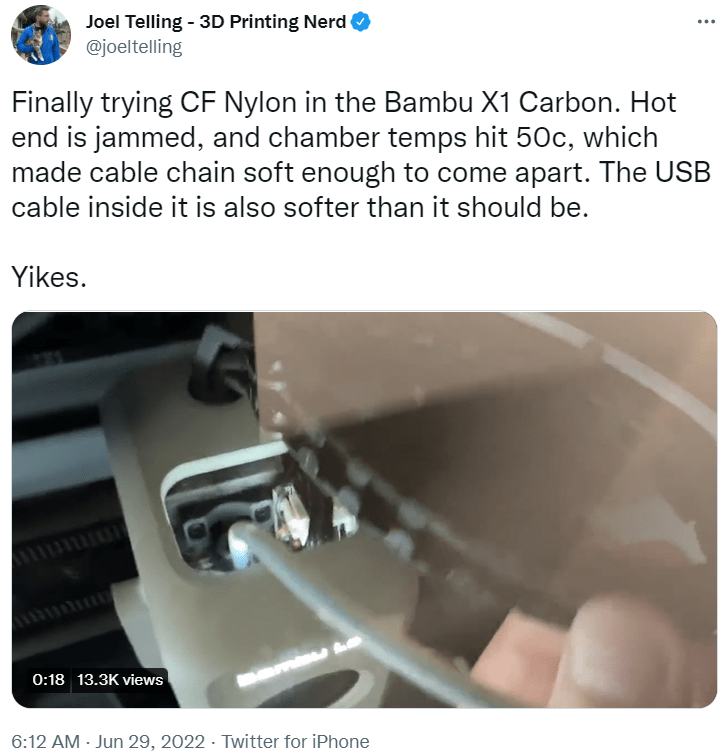
Such complaints are not regular. There is a possibility that rivals are making buzz on negative sides or there might be some real problems. We have talked with Bambu Lab’s management and they have shown positive consent that they have already sorted out the issues.
The Extruder
Prusa XL accompanies 5 different extruders and those can swap in between depending on their job. The whole process is automated and controlled through their cloud application. The X1 Carbon’s extruder is plastic made which is good for cleaning if there are any clogged filaments inside. Prusa claims their extruder’s name as ‘Nextruder’ because of its dynamism. They also offer a dedicated CPU along with stepper drivers directly attached to the Nextruders so that the users do not face any trouble.
On the contrary, X1 Carbon’s extruder rail is super light so that it can move freely and fast. Makerbot’s Method X also offers an industrial-grade super efficient extruder with a 19:1 gear ratio.
One negative side the experts are worried about the possibility that the Prusa xl can cause warping with ASA or PC PBT filaments while used without the enclosures.
Let’s compare Troodon’s Extrusion Vs Bambu Lab’s output
Troodon is currently playing a major role as the toughest Bambu Lab competitor. Apart from the larger build plate than Bambu Lab, it offers even better extrusion. The TMC2660 Driver works awesome with its dual gear extrusion.
From the survey we did, this is affirmed that the Troodon’s gates belts and linear guide rails worked excellently in terms of positioning precession and accuracy.
Let us compare extrusion quality between X1 Carbon and Trooder. Here’s what the X1 carbon surprised one of the renowned 3d print experts once:
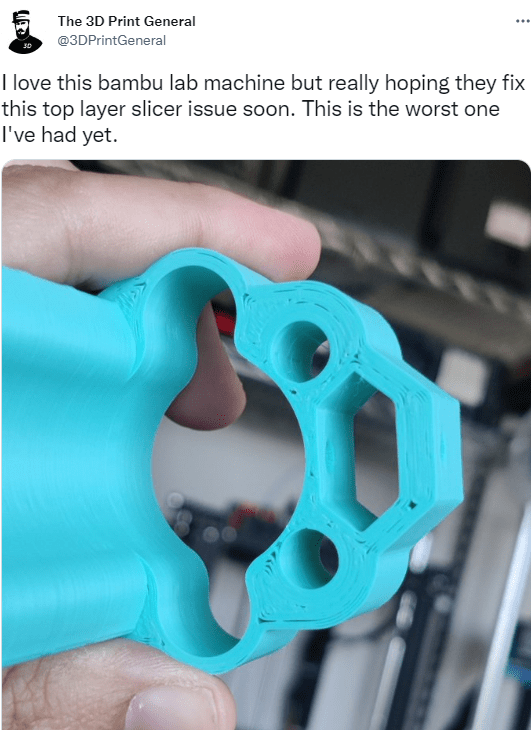
Sounds crazy right? Well, sometimes slicer settings and other issues can vary the end result of a 3d printer. The same thing has also happened with Ender, Prusa, and Makerbot earlier. This is just for your concern, not to demotivate you from buying the product.
To avoid such qualitative errors, you need to look at temperature settings or consider replacing the nozzle in need. Often outdated filaments or faster print speed can cause such issues.
So, don’t panic.
Here’s what we also made with Bambu Lab and there has been no error so far!

We have also seen some good results by Voron 2.4 (a low price edition by the company that sells Troodon)

This is true that the Bambu lab has announced its X factor, the artificial intelligence which inspects 3d print quality. However, the AI notification is less important than the actual result we are receiving from its competitors.
If you go through the Reddit threads, users have also shown the intention to buy Troodon with the money they are keeping for X1 Carbon.
This is why we have suggested Troodon so boldly.

Voron 2.4 is another beast but its open source
The Voron 2.4 comes within $1000 with an option of an extended build plate. You can consider him as a light version of the Troodon but with the same Core XY and dual extrusion.
Being an open source 3d printer, there would not be any guarantee for the amazing features like Bam bu Lab. Its a DIY printer and you need to build it which also requires technical knowledge.
In Voron, you will also have the option to choose between the standard flow and higher flow nozzle which also takes more price. In our opinion, the company tries to reduce the costs by restricting the pre-assembled version and steel sheet enclosure.
You need to build it after you buy it.
Voron 2.4 is very popular for its printing speed of 400 mm/s with higher precision and accuracy. This is also a direct drive extrusion that may allow you comparably slower speed in comparison to the Bowden extrusion.
TMC2209 stepper drivers ensure maximum noise cancellation with a torque ratio of 3:1. This is a DIY 3d printing machine with an affordable price. The quality it produces is even better than what Bambu Lab’s X1 Carbon offers.
so far we did not see any negative issues with this 3d printer.

Voron may produce a better quality of 3d prints but, it cannot be directly compared with branded 3d printers like Bambu Lab. If you are a 3d printing pro – You can easily go for a Voron.
How Makerbot Method outweighs Bambu Lab’s X1 Carbon?
Nothing to say about the company experience that helped Makerbot to develop such a premium product. Though, the build plate is a bit lower than what X1 Carbon and Troodon offers but there are something else that can motivate you to buy the Makerbot.
Here’s what we made with Makerbot earlier –

Firstly, the cloud platform that Makerbot developed is just awesome. They named it ‘Makerbot Cloudprint 2.0‘ which assists you in multiple advantages as follows:
- You can print/control 3d printing from anywhere
- Even a team can use the same printer with the help of its Queue management
- The dashboard is excellent and rich with analytics
- The workflow can modify the print profile regardless of where you are
- It does not require you to convert the native files
- Most importantly, the cloud print helps in printing multiple files within the save time which ultimately saves costs & time
Also, Makerbot is extremely overpriced but in exchange for premium services. For example,
Their noise and temperature controlling mechanism are way above what others are offering. Accuracy is even higher than what Trooder offers. This is so helpful while working with lightweight applications such as robotics.
Similarly, Method X is so good with carbon fiber and ABS. Material and nozzle changing time and process are 50% lesser than the Prusa.
Experts believe that users should not worry even if they are crossing more than 3,00,000 hours of printing with Method X.
So, Would you buy Makerbot at a premium price?
The direct response would be ‘Yes’ if you are aware of premium services for higher money. But, considering the price, flexibility of usage and other features as mentioned earlier – Bambu Lab X1 can be really a good choice indeed.
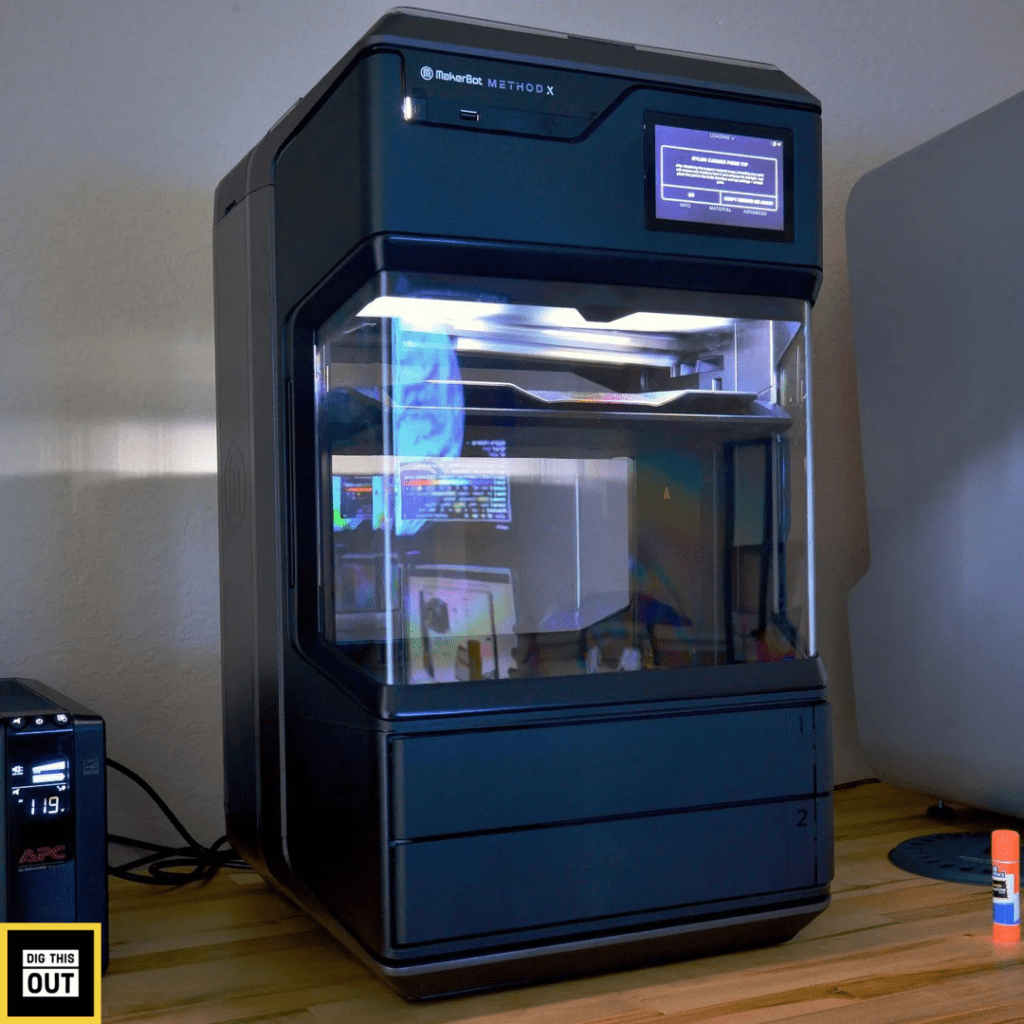
Other Features
There are premium features that are pretty common in all 3d printers having a price of more than $1500. For example, Bambu Lab’s X1 Carbon offers filament switching, an accuracy detector, power outage memory restoration, thermal cooling, noise cancellation, and cloud operating.
However, Bambu Lab did not disclose whether the X1 carbon can actually print multiple models at the same time as the MakerBot! We assume that it cannot. In addition, X1 Carbon holds a 12-watt cooling fan and that creates a lot of noise due to the higher RPM.
However, a higher RPM is good to cool down the 3d printer quickly. In-fact noise may not be an issue when there is a closed loop cooling mechanism.
We still recommend you use a filament cleaner to save the nozzle from clogging and the extruder from dust. For more, read our definitive guide on the solution to 3d printing noise.
Still, we are waiting to see how Prusa XL performs with its partial bed heating mechanism. Surely it will have proper control over the chamber temperature and there will be a direct contribution to noise control.
Conclusion
Undoubtedly X1 carbon is a great introduction by the Bambu lab but, the hype seems to be too high compared to the products from its comparison. We still motivate you to explore more about the product and make the right decision based on the available factors. For now, we will be recommending Makerbot Method X Carbon and Trooder as the most suitable option on top of the X1 carbon.
Good luck!

Top site ,.. amazaing post ! Just keep the work on !